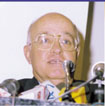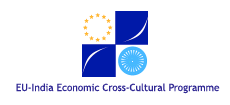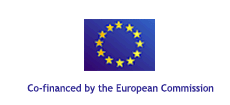
Austria is a small country. India is 40 times as large and has 120 times as many inhabitants. Cities like Mumbai, Delhi or Calcutta have many more inhabitants than the whole of Austria. Nevertheless, Austria belongs to the group of the ten richest countries in the world in terms of per capita income (USD 25,000). Austria has a GNPof approximately USD 200 billion, exports of approximately USD 60 billion and imports of approximately USD 65 billion. The unemployment rate is as low as 4.5%. Direct foreign investment into Austria since 1995 was of the order of USD 13 billion.
As shown above, Austria has a negative trade balance. This negative balance is, however, compensated by high income from tourism. Austria achieves approximately 110 million bednights p.a. Twelve million tourists visit the country annually and leave USD 11 billion behind. Almost 3% of GNP goes into R&D with focal points on IT, telecom, medical technology, environmental technology, water, metallurgy etc.
At present, about 50 Austrian companies have joint venture agreements with Indian partners and more than 100 Austrian companies have concluded technical co-operation agreements with India. I would like to give you just a few examples: VA-Tech Elin (manufacture of generators in Bophal), AVL (manufacture of exhaust testing implements in Delhi); Hoerbiger (compressor valves in Pune); AT&S (printed circuits in Mysore); SDP (motor development in Pune); Swarovski (artificial pearls in Pune); Hirsch (watchstraps in Hosur); Natex (essential oil extraction). This list is – by no means – exhaustive and should serves only to demonstrate the many-sided involvement of Austrian companies in India. I should also like to mention that at present around 300 Austrian companies are regularly doing business with India, either exporting to India or importing from India.
Austria ’s bilateral trade with India has taken a considerable upswing since the introduction of reform measures and the liberalisation of foreign trade. Our exports surged from ATS 860 million in 1993 to ATS 1760 million in 1996 but have suffered a setback since then.
In 1998, Austria’s exports to India amounted to only ATS 1340 million. India’s exports to Austria have fared much better. They rose from ATS 1700 million in 1993 to almost ATS 2 billion last year.
The most important export items from Austria to India are machinery, transport equipment, chemical products, paper, metal goods, measuring equipment and steel. India exports to Austria mainly garments and textiles, leather and leather goods, coffee, machinery, chemical products, metal goods, jewellery and precious stones etc. It is noteworthy that India has established itself in areas that were not previously considered to be conventional export sectors for the country, such as, for example, machinery.
Let me briefly say a few words on the Austrian project business in India. First and foremost, I must mention here a breakthrough in the steel sector. India is – after South Africa and Korea – the third country in the world to have installed a COREX-Plant, in Vijayanagar. COREX is a new technology to produce steel using low-grade coal and at the same time safeguarding the environment because the waste gas generated can be re-used in the process. Other projects which have been realised in the recent past are a slab caster for Bokaro, equipment for a good number of hydroelectric power plants, a fruit processing plant near Srinagar in Kashmir, a tractor plant and many others. It is worth mentioning that VA-Tech has recently signed a contract for a hydropower plant in Karnataka (Sarapadi) and for the installation of 3 desalination plants in Tamil Nadu.
It is a great pleasure to me that this event, which has been organised within the framework of the "EU-India Economic Cross-Cultural Programme", has brought together experts from Italy and Austria under the auspices of the B.M. Birla Science Centre. I hope that the pilot project on hydrology and groundwater management and conservation will contribute to an increased cooperation in practical terms between EU countries and India. I should also like to express my thanks to the B.M. Birla Science Centre for having orgainised this event in such an impeccable way.

